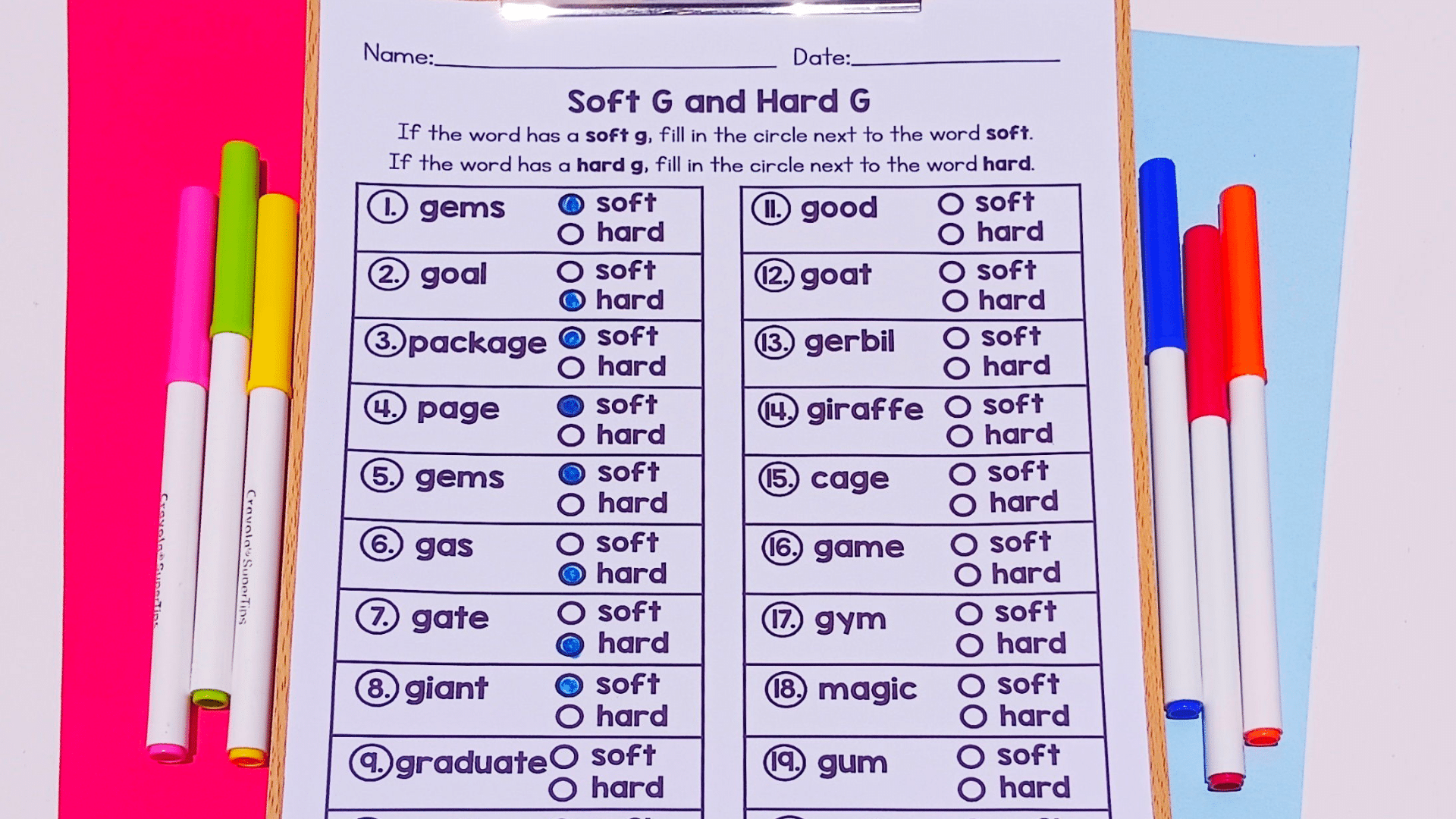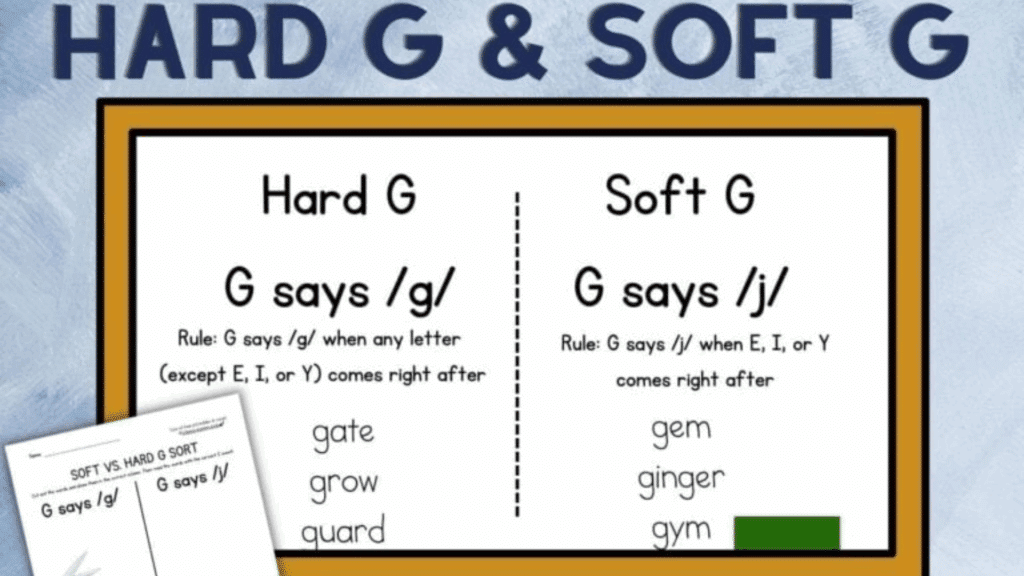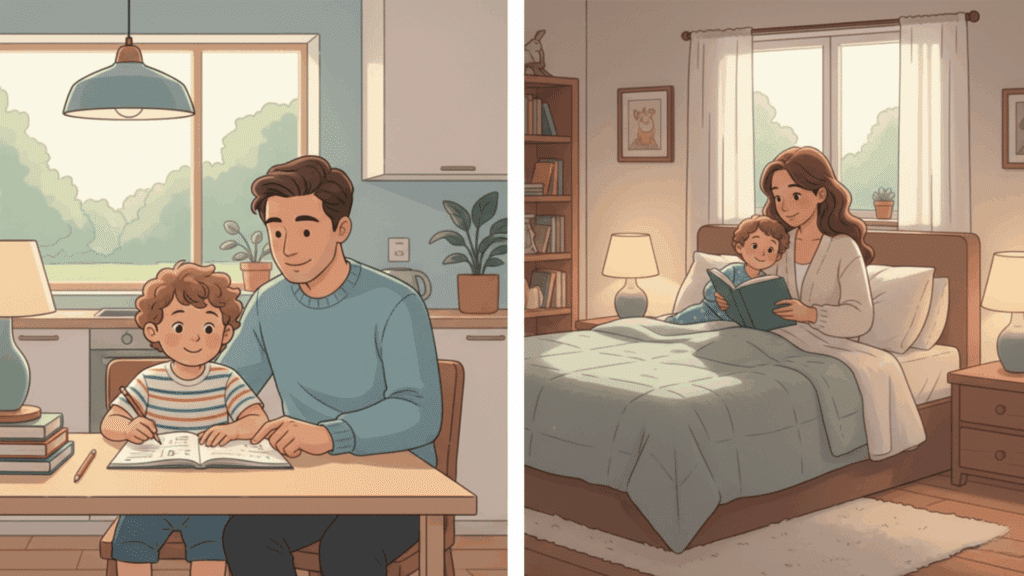Teaching children to read can become frustrating when they encounter the letter G, which makes different sounds in similar-looking words. Students often struggle with “goat” versus “giant” or “gate” versus “gentle,” not understanding why G behaves differently.
This blog will show you simple rules that predict when G makes its hard or soft sound. You’ll learn reliable patterns that work for most English words, plus effective teaching strategies that stick.
We’ll cover the basic hard and soft G rules, common word patterns, helpful memory tricks, and practical activities to reinforce the material.
Teachers and parents will gain clear methods to explain this tricky concept and help children read G words with confidence and accuracy.
Difference Between Hard and Soft G Words
| Category | Hard G | Soft G |
|---|---|---|
| Sound Production | Same sound as in “go” or “game” – made at the back of the throat | Same sound as letter J – as in “gentle” or “giant” |
| Vowel Pattern Rules | Typically appears before A, O, U – e.g., gate, goat, gum | Usually appears before E, I, Y – e.g., gem, giraffe, gym |
| Visual Clues | Words starting with ga-, go-, gu- usually have a hard G | Words starting with ge-, gi-, gy- usually have a soft G |
| Spelling Implications | “G” is used when the sound is hard, even if followed by A, O, or U | “G” can make a J sound before E, I, or Y – helps choose G vs. J spelling |
| Reading Strategies | Use vowel cues to expect a hard G – e.g., garage (first syllable) | Use vowel cues to expect a soft G – e.g., magazine (soft G before E) |
| Frequency of Use | More common in basic vocabulary and daily use | Found more in advanced words with Latin or French roots |
The Core List of Common Hard and Soft G Words
Check out a helpful list of common words with both hard and soft G sounds. Perfect for building phonics skills and boosting reading confidence in early learners.
Hard G Words
These words begin with or include the hard G sound, like in “go” or “gum” (/g/).
1. Game
2. Go
3. Gorilla
4. Garden
5. Gate
6. Gum
7. Gift
8. Gold
9. Grape
10. Glass
11. Golf
12. Goose
13. Girl
14. Gap
15. Gallon
16. Gown
17. Gravy
18. Globe
19. Grain
20. Grass
Soft G Words
These words use the soft G sound, like in “giant” or “giraffe” (/j/).
21. Gem
22. Giant
23. Giraffe
24. Gentle
25. Ginger
26. Gym
27. Germ
28. General
29. Genius
30. Gender
31. Gene
32. Generous
33. Geometry
34. Gesture
35. Geology
36. Genius
37. Genuine
38. Geography
39. Genie
40. Gel
Teaching Tools to Teach Hard and Soft G Effectively

Making the hard and soft G concept stick requires hands-on tools and engaging activities that children can see, touch, and practice with. The right teaching materials transform this abstract phonics rule into something concrete and memorable
1. Color-Coded Word Cards
Use different colored cards to represent hard G (e.g., green) and soft G (e.g., blue) words. This visual aid helps kids categorize and remember the sounds more easily.
- Skills Practiced: Visual sorting, sound identification
- Materials Needed: Index cards, markers, word list
2. Letter Manipulation Activities
Let kids build words using letter tiles or magnetic letters to explore how G changes based on the following vowel. Focus on patterns like G followed by E, I, or Y.
- Skills Practiced: Phonics rules, word construction
- Materials Needed: Letter tiles or magnets, trays or boards
3. Interactive Sound Charts
Create a chart with movable parts where kids can sort or match hard and soft G words. Add pictures and sound buttons for a multi-sensory experience.
- Skills Practiced: Sound discrimination, vocabulary reinforcement
- Materials Needed: Chart board, Velcro pieces, pictures/audio
4. Movement and Gesture Games
Pair sounds with motions—stomp for hard G, wave for soft G. These kinesthetic games link physical activity with phonemic awareness.
- Skills Practiced: Gross motor skills, auditory processing
- Materials Needed: Open space, prepared word list
5. Story-Based Learning Tools
Use short stories or picture books that emphasize hard and soft G words. Pause to highlight and pronounce each word, building context through storytelling.
- Skills Practiced: Listening comprehension, contextual learning
- Materials Needed: G-focused storybooks, highlighters or sticky notes
6. Digital Learning Apps
Use apps with phonics games that let children tap, hear, and sort G sounds. Many programs offer instant feedback and engaging visuals for better retention.
- Skills Practiced: Interactive learning, self-paced phonics drills
- Materials Needed: Tablet or computer, age-appropriate app
Worksheets and Practice Ideas

Consistent practice through varied worksheets and activities helps children master the hard and soft G concept. These practice ideas are practical for both classroom instruction and home learning sessions.
Word Sorting Worksheets
Create engaging worksheets that feature a mix of hard and soft G words for children to sort into two columns. Words like “game,” “gem,” “goose,” “giraffe,” “garden,” and “gentle” provide a balanced variety for practice.
As students categorize each word based on its G sound, they strengthen their phonemic awareness and sharpen their ability to analyze word patterns.
Word Building Activities
Create worksheets where children add different vowels after the letter G to form new words. For example, “G + A” makes “gate,” “G + E” makes “gentle,” and “G + O” makes “goat.”
This hands-on activity reinforces how vowels influence G’s sound, while building phonics and spelling skills.
Reading Passage Practice
Write short passages filled with both hard and soft G words. After reading, children underline all the G words and sort them into hard and soft G categories.
This activity strengthens decoding skills, boosts reading fluency, and helps them recognize phonics patterns in context.
Crossword and Word Search Puzzles
Design simple, age-appropriate puzzles using hard and soft G words. Use crossword clues that highlight sound differences, for example, “Soft G word for a tall person” (giant) or “Hard G word for a farm animal” (goat).
This strengthens spelling recall, pattern recognition, and builds vocabulary through fun, focused problem-solving.
Error Correction Exercises
Create sentences with intentionally mispronounced G words, such as “The giraffe ran with a hard G sound.” Ask children to spot and correct the mistake based on G sound rules.
This activity builds editing skills, reinforces phonics rules, and sharpens analytical thinking through active error detection.
G Sound Exceptions and Challenges
Even with clear rules, the letter G presents several exceptions and tricky situations that can confuse learners. Understanding these challenges helps teachers and parents address standard stumbling blocks.
- Words that break the vowel rules: “Girl,” “give,” and “get” contain G followed by I or E, but make the complex sound instead of the expected soft sound
- Silent G combinations: Words like “gnome,” “gnat,” and “sign” contain G letters that aren’t pronounced at all, creating confusion for beginning readers.
- Double G situations: “Egg,” “rugged,” and “agger” show how double G letters can affect pronunciation and don’t follow standard single G rules.
- GH letter combinations: “Laugh,” “rough,” and “ghost” contain GH that make completely different sounds or stay silent, not following G sound patterns.
Conclusion
Mastering hard and soft G sounds takes practice, but the basic vowel rules provide a solid foundation for most words. Remember that G followed by A, O, or U makes a complex sound, while G before E, I, or Y usually makes a soft sound.
Exceptions exist, but they’re manageable with consistent exposure and practice. Utilize a variety of teaching tools, engaging worksheets, and regular review to reinforce these concepts.
Focus on the patterns that work most often rather than getting overwhelmed by exceptions.
With patience and the right approach, children will confidently tackle G words and become stronger, more fluent readers overall.


















